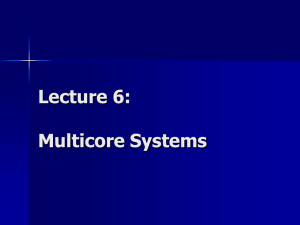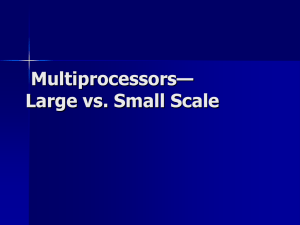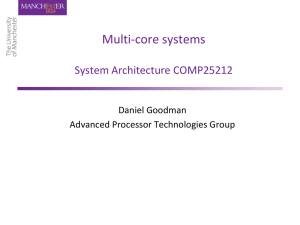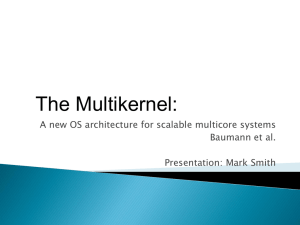PPT - ECE/CS 552 Fall 2010 - University of Wisconsin–Madison
advertisement
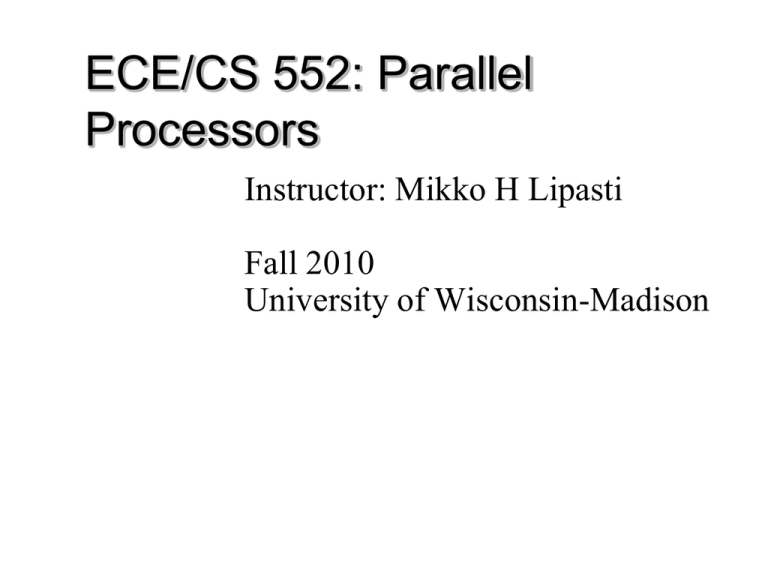
ECE/CS 552: Parallel Processors Instructor: Mikko H Lipasti Fall 2010 University of Wisconsin-Madison Parallel Processors Why multicore now? Thread-level parallelism Shared-memory multiprocessors – Coherence – Memory ordering – Split-transaction buses Multithreading Multicore processors 2 © Hill, Lipasti Why Multicore Now? Moore’s Law for device integration Chip power consumption Single-thread performance trend [source: Intel] Leakage Power (Static/DC) Source Transistors aren’t perfect on/off switches Even in static CMOS, transistors leak – Channel (source/drain) leakage – Gate leakage through insulator High-K dielectric replacing SiO2 helps Leakage compounded by – Low threshold voltage Low Vth => fast switching, more leakage High Vth => slow switching, less leakage – Higher temperature Temperature increases with power Power increases with C, V2, A, f Rough approximation: leakage proportional to area – Transistors aren’t free, unless they’re turned off Gate Controlling leakage – Power gating (turn off unused blocks) Drain Dynamic Power Pdyn kCV Af 2 Aka AC power, switching power Static CMOS: current flows when transistors turn on/off – Combinational logic evaluates – Sequential logic (flip-flop, latch) captures new value (clock edge) Terms – – – – C: capacitance of circuit (wire length, no. & size of transistors) V: supply voltage A: activity factor f: frequency Moore’s Law: which terms increase, which decrease? – Historically voltage scaling has saved us, but not any more Reducing Dynamic Power Reduce capacitance – Simpler, smaller design – Reduced IPC Reduce activity – Smarter design – Reduced IPC Reduce frequency – Often in conjunction with reduced voltage Reduce voltage – Biggest hammer due to quadratic effect, widely employed – However, reduces max frequency, hence performance – Dynamic (power modes) E.g. Transmeta Long Run, AMD PowerNow, Intel Speedstep Frequency/Voltage relationship Lower voltage implies lower frequency – Lower Vth increases delay to sense/latch 0/1 Conversely, higher voltage enables higher frequency – Overclocking Sorting/binning and setting various Vdd & Vth – Characterize device, circuit, chip under varying stress conditions – Black art – very empirical & closely guarded trade secret – Implications on reliability Safety margins, product lifetime This is why overclocking is possible Frequency/Voltage Scaling Voltage/frequency scaling rule of thumb: – +/- 1% performance buys -/+ 3% power (3:1 rule) Hence, any power-saving technique that saves less than 3x power over performance loss is uninteresting Example 1: – – – – New technique saves 12% power However, performance degrades 5% Useless, since 12 < 3 x 5 Instead, reduce f by 5% (also V), and get 15% power savings Example 2: – New technique saves 5% power – Performance degrades 1% – Useful, since 5 > 3 x 1 Does this rule always hold? Multicore Mania First, servers – IBM Power4, 2001 Then desktops – AMD Athlon X2, 2005 Then laptops – Intel Core Duo, 2006 Your cellphone – Baseband/DSP/application/graphics Why Multicore Core Core Core Core Core Core Core Single Core Dual Core Quad Core Core area A ~A/2 ~A/4 Core power W ~W/2 ~W/4 Chip power W+O W + O’ W + O’’ Core performance P 0.9P 0.8P Chip performance P 1.8P 3.2P Amdahl’s Law # CPUs n f 1 f 1-f Time f – fraction that can run in parallel 1-f – fraction that must run serially Speedup 1 f (1 f ) n 1 1 lim n f 1 f 1 f n Fixed Chip Power Budget # CPUs n 1 f 1-f Amdahl’s Law Time – Ignores (power) cost of n cores Revised Amdahl’s Law – – – – More cores each core is slower Parallel speedup < n Serial portion (1-f) takes longer Also, interconnect and scaling overhead Fixed Power Scaling 128 Chip Performance 64 32 99.9% Parallel 16 99% Parallel 8 90% Parallel 4 80% Parallel 2 1 1 2 4 8 16 32 64 128 # of cores/chip Fixed power budget forces slow cores Serial code quickly dominates Multicores Exploit Thread-level Parallelism Instruction-level parallelism – Reaps performance by finding independent work in a single thread Thread-level parallelism – Reaps performance by finding independent work across multiple threads Historically, requires explicitly parallel workloads – Originate from mainframe time-sharing workloads – Even then, CPU speed >> I/O speed – Had to overlap I/O latency with “something else” for the CPU to do – Hence, operating system would schedule other tasks/processes/threads that were “time-sharing” the CPU Thread-level Parallelism Reduces effectiveness of temporal and spatial locality Thread-level Parallelism Motivated by time-sharing of single CPU – OS, applications written to be multithreaded Quickly led to adoption of multiple CPUs in a single system – Enabled scalable product line from entry-level single-CPU systems to high-end multiple-CPU systems – Same applications, OS, run seamlessly – Adding CPUs increases throughput (performance) More recently: – Multiple threads per processor core Coarse-grained multithreading Fine-grained multithreading Simultaneous multithreading – Multiple processor cores per die Chip multiprocessors (CMP) Chip multithreading (CMT) Multicore and Multiprocessor Systems Focus on shared-memory symmetric multiprocessors – – Many other types of parallel processor systems have been proposed and built Key attributes are: – Shared memory: all physical memory is accessible to all CPUs Symmetric processors: all CPUs are alike Other parallel processors may: Share some memory, share disks, share nothing – E.g. GPGPU unit in the textbook May have asymmetric processing units or noncoherent caches Shared memory idealisms – – – – Fully shared memory: usually nonuniform latency Unit latency: approximate with caches Lack of contention: approximate with caches Instantaneous propagation of writes: coherence required UMA vs. NUMA Cache Coherence Problem Load A Store A<= 1 P0 A P1 01 A Memory 0 Load A Load A Cache Coherence Problem Load A Store A<= 1 P0 P1 A 1 0 A 1 0 Memory Load A Load A Invalidate Protocol Basic idea: maintain single writer property – Only one processor has write permission at any point in time Write handling – – – – On write, invalidate all other copies of data Make data private to the writer Allow writes to occur until data is requested Supply modified data to requestor directly or through memory Minimal set of states per cache line: – Invalid (not present) – Modified (private to this cache) State transitions: – Local read or write: I->M, fetch modified – Remote read or write: M->I, transmit data (directly or through memory) – Writeback: M->I, write data to memory Invalidate Protocol Optimizations Observation: data can be read-shared – Add S (shared) state to protocol: MSI State transitions: – – – – Local read: I->S, fetch shared Local write: I->M, fetch modified; S->M, invalidate other copies Remote read: M->S, supply data Remote write: M->I, supply data; S->I, invalidate local copy Observation: data can be write-private (e.g. stack frame) – Avoid invalidate messages in that case – Add E (exclusive) state to protocol: MESI State transitions: – Local read: I->E if only copy, I->S if other copies exist – Local write: E->M silently, S->M, invalidate other copies Sample Invalidate Protocol (MESI) BR Sample Invalidate Protocol (MESI) Current State s Event and Local Coherence Controller Responses and Actions (s' refers to next state) Local Read (LR) Local Write (LW) Local Eviction (EV) Bus Read (BR) Bus Write (BW) Bus Upgrade (BU) Issue bus read if no sharers then s' = E else s' = S Issue bus write s' = M s' = I Do nothing Do nothing Do nothing Shared (S) Do nothing Issue bus upgrade s' = M s' = I Respond shared s' = I s' = I Exclusive (E) Do nothing s' = M s' = I Respond shared s' = S s' = I Error Modified (M) Do nothing Do nothing Write data back; s' = I Respond dirty; Write data back; s' = S Respond dirty; Write data back; s' = I Error Invalid (I) Snoopy Cache Coherence Snooping implementation – – Origins in shared-memory-bus systems All CPUs could observe all other CPUs requests on the bus; hence “snooping” – Bus Read, Bus Write, Bus Upgrade React appropriately to snooped commands Invalidate shared copies Provide up-to-date copies of dirty lines – – Flush (writeback) to memory, or Direct intervention (modified intervention or dirty miss) Directory Cache Coherence Directory implementation – – – Extra bits stored in memory (directory) record MSI state of line Memory controller maintains coherence based on the current state Other CPUs’ commands are not snooped, instead: – – Ideal filtering: only observe commands that you need to observe Meanwhile, bandwidth at directory scales by adding memory controllers as you increase size of the system Directory forwards relevant commands Leads to very scalable designs (100s to 1000s of CPUs) Can provide both snooping & directory – AMD Opteron switches based on socket count Memory Consistency How are memory references from different processors interleaved? If this is not well-specified, synchronization becomes difficult or even impossible – ISA must specify consistency model – – If load reordered ahead of store (as we assume for an OOO CPU) Both Proc0 and Proc1 enter critical section, since both observe that other’s lock variable (A/B) is not set Common example using Dekker’s algorithm for synchronization If consistency model allows loads to execute ahead of stores, Dekker’s algorithm no longer works – Common ISAs allow this: IA-32, PowerPC, SPARC, Alpha Sequential Consistency [Lamport 1979] Processors treated as if they are interleaved processes on a single time-shared CPU All references must fit into a total global order or interleaving that does not violate any CPUs program order – Otherwise sequential consistency not maintained – Hence precludes any real benefit from OOO CPUs Now Dekker’s algorithm will work Appears to preclude any OOO memory references High-Performance Sequential Consistency Coherent caches isolate CPUs if no sharing is occurring – Absence of coherence activity means CPU is free to reorder references Still have to order references with respect to misses and other coherence activity (snoops) Key: use speculation – – – Reorder references speculatively Track which addresses were touched speculatively Force replay (in order execution) of such references that collide with coherence activity (snoops) High-Performance Sequential Consistency Load queue records all speculative loads Bus writes/upgrades are checked against LQ Any matching load gets marked for replay At commit, loads are checked and replayed if necessary – Results in machine flush, since load-dependent ops must also replay Practically, conflicts are rare, so expensive flush is OK Multithreading Basic idea: CPU resources are expensive and should not be left idle 1960’s: Virtual memory and multiprogramming – VM/MP invented to tolerate latency to secondary storage (disk/tape/etc.) – Processor:secondary storage cycle-time ratio: microseconds to tens of milliseconds (1:10000 or more) – OS context switch used to bring in other useful work while waiting for page fault or explicit read/write – Cost of context switch must be much less than I/O latency (easy) 1990’s: Memory wall and multithreading – Processor: non-cache storage cycle-time ratio: nanosecond to fractions of a microsecond (1:500 or worse) – H/W task switch used to bring in other useful work while waiting for cache miss – Cost of context switch must be much less than cache miss latency Very attractive for applications with abundant thread-level parallelism – Commercial multi-user workloads Approaches to Multithreading Fine-grained multithreading – Switch contexts at fixed fine-grain interval (e.g. every cycle) – Need enough thread contexts to cover stalls – Example: Tera MTA, 128 contexts, no data caches Benefits: – Conceptually simple, high throughput, deterministic behavior Drawback: – Very poor single-thread performance Approaches to Multithreading Coarse-grained multithreading – Switch contexts on long-latency events (e.g. cache misses) – Need a handful of contexts (2-4) for most benefit Example: IBM Northstar, 2 contexts Benefits: – Simple, improved throughput (~30%), low cost – Thread priorities mostly avoid single-thread slowdown Drawback: – Nondeterministic, conflicts in shared caches – Not suitable for out-of-order processors Approaches to Multithreading Simultaneous multithreading – Multiple concurrent active threads (no notion of thread switching) – Need a handful of contexts for most benefit (2-8) Example: Intel P4, Core i7, IBM Power 5/6/7, Benefits: – Natural fit for OOO superscalar – Improved throughput – Low incremental cost Drawbacks: – Additional complexity over OOO superscalar – Cache conflicts SMT Microarchitecture (from Emer, PACT ‘01) Multithreading with Multicore Chip Multiprocessors (CMP) Share nothing in the core: – Implement multiple cores on die – Perhaps share L2, system interconnect (memory and I/O bus) Example: IBM Power4, 2 cores per die, shared L2 Benefits: – – – – Simple replication Packaging density Low interprocessor latency ~2x throughput Drawbacks: – L2 shared – conflicts – Mem bandwidth shared – could become bottleneck Approaches to Multithreading Chip Multiprocessors (CMP) Becoming very popular Processor MultiResources shared threaded? IBM Power 4 Cores/ chip 2 No L2/L3, system interface IBM Power 5 2 Yes (2T) Core, L2/L3, system interface Sun Ultrasparc 2 No System interface Sun Niagara 8 Yes (4T) Everything Intel Pentium D 2 Yes (2T) Core, nothing else Intel Core i7 4 Yes L3, DRAM, system interface AMD Opteron 2, 4, 6, 12 No L3, DRAM, system interface Approaches to Multithreading Chip Multithreading (CMT) – Similar to CMP Share something in the core: – Expensive resource, e.g. floating-point unit (FPU) – Also share L2, system interconnect (memory and I/O bus) Example: – Sun Niagara, 8 cores, one FPU – AMD Bulldozer, FPU shared by two adjacent cores Benefit: amortize cost of expensive resource Drawbacks: – Shared resource may become bottleneck – Next generation Niagara does not share FPU Multithreaded Processors MT Approach Resources shared between threads Context Switch Mechanism None Everything Explicit operating system context switch Fine-grained Everything but register file and control logic/state Switch every cycle Coarse-grained Everything but I-fetch buffers, register file and con trol logic/state Switch on pipeline stall SMT Everything but instruction fetch buffers, return address stack, architected register file, control logic/state, reorder buffer, store queue, etc. All contexts concurrently active; no switching CMT Various core components (e.g. FPU), secondary cache, system interconnect All contexts concurrently active; no switching CMP Secondary cache, system interconnect All contexts concurrently active; no switching Many approaches for executing multiple threads on a single die – Mix-and-match: IBM Power7 8-core CMP x 4-way SMT IBM Power4: Example CMP Niagara Case Study Targeted application: web servers – Memory intensive (many cache misses) – ILP limited by memory behavior – TLP: Lots of available threads (one per client) Design goal: maximize throughput (/watt) Results: – – – – Pack many cores on die (8) Keep cores simple to fit 8 on a die, share FPU Use multithreading to cover pipeline stalls Modest frequency target (1.2 GHz) Niagara Block Diagram [Source: J. Laudon] 8 in-order cores, 4 threads each 4 L2 banks, 4 DDR2 memory controllers Ultrasparc T1 Die Photo [Source: J. Laudon] Niagara Pipeline [Source: J. Laudon] Shallow 6-stage pipeline Fine-grained multithreading T2000 System Power 271W running SpecJBB2000 Processor is only 25% of total DRAM & I/O next, then conversion losses Niagara Summary Example of application-specific system optimization – Exploit application behavior (e.g. TLP, cache misses, low ILP) – Build very efficient solution Downsides – Loss of general-purpose suitability – E.g. poorly suited for software development (parallel make, gcc) – Very poor FP performance (fixed in Niagara 2) Summary Why multicore now? Thread-level parallelism Shared-memory multiprocessors – Coherence – Memory ordering – Split-transaction buses Multithreading Multicore processors 47 © Hill, Lipasti
